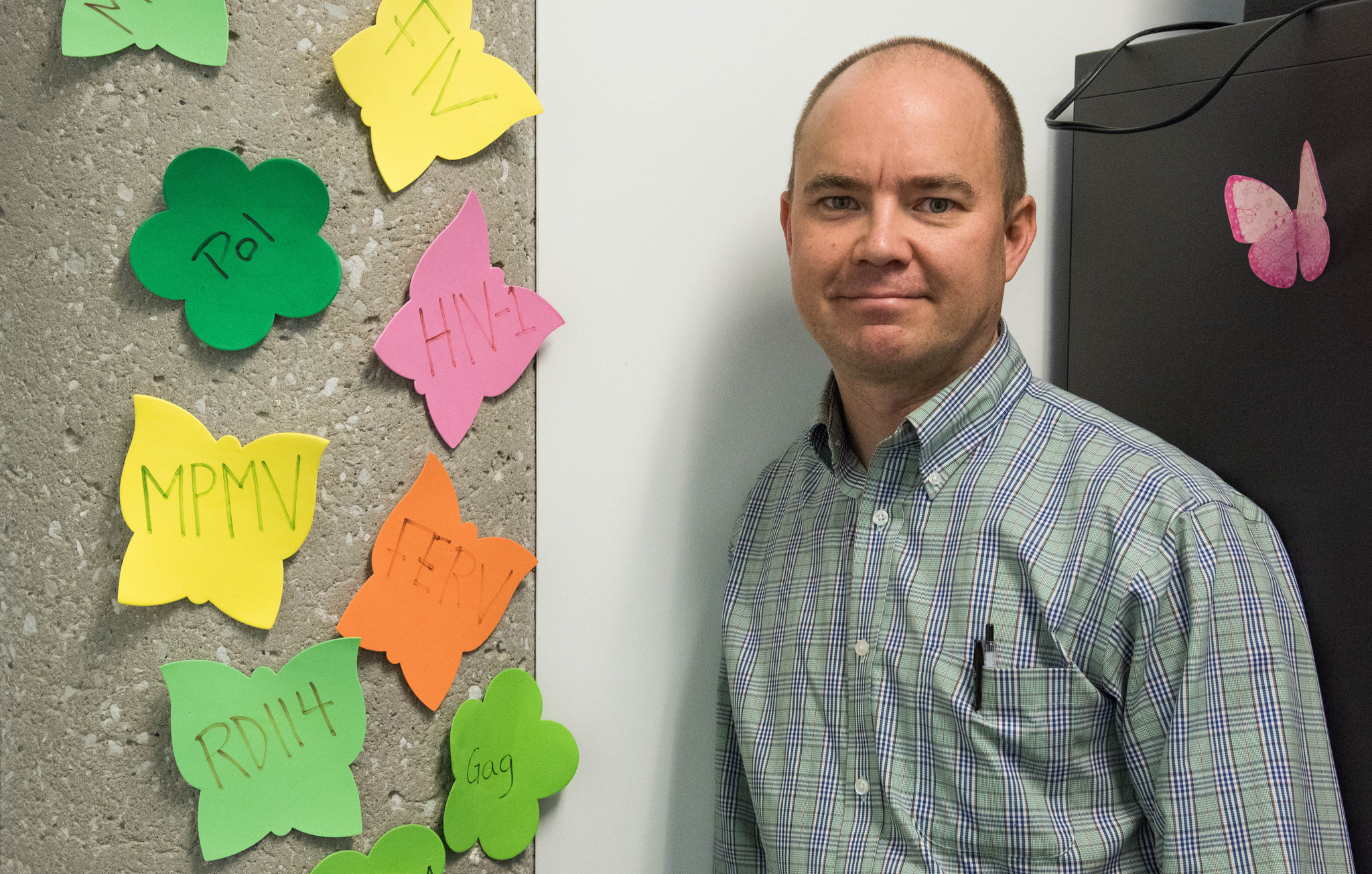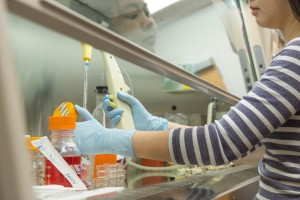
Nineteen colorful foam flowers decorate the walls of Marc Johnson’s office, a memento from his lab members when they “redecorated” while he was out of town.
Each flower is labeled in bold Sharpie with the names of viruses and viral proteins that his lab studies—MLV, RSV, Gag, Pol, to name a few.
One flower stands out, marked in capital letters: H-I-V.
Johnson, an associate professor of molecular microbiology and immunology, is one of four researchers at Bond LSC who studies HIV, the virus that leads to AIDS. His research focuses on understanding how HIV assembles copies of itself with help from the cells it infects.
Like most viruses, HIV hijacks cellular functions for its own purposes.
“It has this tiny itty bitty little genome and yet it can infect 30 million people,” Johnson said. “It doesn’t do it by itself.”
To understand how viruses reprogram the proteins in our bodies to work against us, he said, you have to understand the cells they infect. If cells were a chamber, then viruses are the keyhole.
For example, cells use a protein called TSG101 to dispose of unwanted surface macromolecules by bending a patch of cellular membrane around the macromolecule until it is surrounded inside a membrane bubble. The process, like trapping a bug inside a sheet of tissue paper, is called budding.
The cell sweeps all the pinched-off bubbles into a larger receptacle, or multivesicular body. These bodies, Johnson said, act as the cell’s garbage collection system. To dispose of the trash, the compartments become acidic enough to disintegrate everything inside or fuse with the cell membrane so that the trash gets dumped outside the cell.
It’s like in the second Star Wars movie, “The Empire Strikes Back,” Johnson said. “They just drop all their garbage before they go into hyperspace, and that’s how the Millennium Falcon got out.”
HIV uses the same housekeeping mechanism to break out of infected cells and infect more cells, but it remains unclear which other host proteins HIV commandeers.
“It’s all part of the puzzle,” Johnson said.
THE GAME CHANGER
On his desk, Johnson keeps a white legal pad with a list of 16 projects written in blue ink.

“Things make it off the list or they’ll get added,” Johnson said. “Or they’ll spend years on the back burner. I have a lot of projects.”
One of the biggest projects involves using CRISPR/Cas9 — a precision gene-editing tool — to identify genes that make a cell resistant to viral infections.
“It’s a game changer. It really is,” Johnson said. “It’s so cool.”
The technology uses a missile-like strand of guide RNA to target specific sites in the genome for deletion. Before CRISPR, scientists had to suppress gene expression using methods that were neither permanent nor absolute.
But because CRISPR manipulates the genome itself, Johnson said, there’s less doubt about what is happening.
Using the CRISPR library, the Johnson lab can scan the effects of 20,000 unique gene deletions in a population of cells. When these cells, each of which contains a different deleted gene, are exposed to HIV, not all of them die. Those that survive can cue researchers in to which genes might be important for blocking HIV infection.
And if another researcher has doubts that a gene is truly knocked out, Johnson said, you can tell them, “I’ll just send you the cell line. You try it and see for yourself.”
A DAY IN THE LIFE
The Johnson lab is a tight-knit group that consists of a lab manager, two grad students, a postdoc and four undergrads.
Dan Cyburt — a third year grad student — studies molecules that interact with proteins that keep HIV from infecting the cell, such as TRIM5α. TRIM5α, a restriction factor, blocks replication of the viral genome.

Fourth year grad student Yuleum Song focuses on how the viral envelope protein, Env, is packaged into viruses before they break free from cells. While Env isn’t necessary for viral assembly and release, she said, it’s critical for the infection of new cells.
Undergrads work in a tag team, picking up where the other left off, to generate a collection of new viral clones.
And lab manager Terri Lyddon keeps day-to-day experiments on task.
Lyddon, who has been with the Johnson lab for ten years, spends much of her day working with cells inside the biosafety level 2 hood. The area is specifically designated for work with moderately hazardous biological agents such as the measles virus, Samonella bacteria, and a less potent version of HIV.
Normally, HIV contains instructions in its genome for making accessory proteins that help the virus replicate, but the HIV strains used in the Johnson lab lack the genes for some of these proteins. That means the handicapped viruses can infect exactly one round of cells and spread no further.
Lyddon also ensures quality control for the lab by making sure students’ work is reproducible.
As a pet project, Johnson also independently confirms new findings reported in academic journals about HIV. Sometimes, Johnson says, the phenotypes that get published are not wrong, but they tend to represent the best outcomes, which might only exist in very specific scenarios.
“They’re only right by the last light of Durin’s day,” Johnson said, making a Lord of the Rings reference to a phenomenon in The Hobbit that reveals the secret entrance to a dwarven kingdom only once a year.
Because scientists base their work on the research of other scientists, he said, it’s always important to check.
A RECONSIDERED POSITION
According to the World Health Organization, 37 million people worldwide in 2014 have HIV or AIDS. The virus infects approximately two million new individuals every year. Breakthroughs in treatment have turned the autoimmune disease from a highly feared death sentence into a chronic and manageable condition.
For the longest time, HIV researchers scrambled to find better therapies against HIV why trying to develop a vaccine that could prevent AIDS.
But in the past five years, Johnson says he’s noticed a shift: researchers are gaining confidence in the possibility of finding a cure, something he once thought was impossible.
“Now it’s been demonstrated that it’s possible to cure a person,” Johnson said, referring to the Berlin patient. “So it’s only going to get easier.”
However, Johnson pointed out, most people would never undergo the kind of high-risk treatment that Timothy Ray Brown, the Berlin patient, received. Brown underwent a bone marrow transplant to treat his leukemia, and his new bone marrow, which came from an HIV-resistant donor, cured him of AIDS.
A “full blown cure” will be hard to attain, but Johnson believes there may be ways for HIV patients to live their lives without having to constantly take medication.
As an example, he points to certain “elite controllers” who are HIV positive but never progress further to show symptoms of AIDS. If scientists can figure out what’s different about their immune systems, Johnson said, then researchers could train the immune response in AIDS patients to resist HIV or keep it in check.
That’s a project for the immunologists. As a basic scientist, Johnson says he adds to the knowledge of how HIV works.
“I am not thinking about a therapy,” Johnson said, “but I’m also acutely aware that some of the best solutions come from basic science. “
Even though scientists haven’t discovered all the mechanisms behind cellular and viral function yet, Johnson said, the rules do exist.
“The sculpture is already there in the stone,” he said.
Johnson’s job is to chip away at the marble until the rules are found.

